Spongy Moth Management for Homeowners
ID
2811-1021 (ENTO-594NP)
Introduction
Spongy moth (Lymantria dispar; formerly called gypsy moth), is an invasive pest of hardwood trees in forests and yards. The caterpillars prefer the foliage of oak and other shade trees, but also attack conifers. Spongy moth caterpillars can defoliate large trees during outbreaks, and most homeowners object to the numerous hairy caterpillars and their abundant droppings raining out of infested trees.
Since its introduction to Massachusetts in 1869, spongy moth has spread throughout the northeastern US, down in the mid-Atlantic, around the Great Lakes, and into Canada. Most of Virginia is generally infested with spongy moth, but it may not cause widespread defoliation every year.
Recognizing Spongy Moth
Spongy moth eggs hatch in early spring when leaves appear on oaks. The young caterpillars are hairy, dark colored, and very small. They spread by drifting short distances on silk threads carried by the wind, often landing on new host trees. Older larvae (Fig. 1) have long hairs, distinctive pairs of blue and red bumps on their backs, and yellow and black markings on the head. Mature caterpillars measure 3.8-6.3 cm (1.5-2.5”) long.

Mature larvae form dark brown pupae with sparse reddish-gold hairs (Fig. 2) in early summer. Pupae measure about 5 cm (2”) long and are typically found hanging upside down on tree bark, leaves, and twigs, or in sheltered areas.

The wedge-shaped adults (Fig. 3) emerge in mid- summer. Adult females are light-colored with darker wavy markings on the wings. Despite having wings, the females cannot fly. Adult males have feathery antennae and are grayish-brown with darker markings on the wings. Females have about a 6 cm (2.5”) wingspan, and males are somewhat smaller with around a 4 cm (1.5”) wingspan.
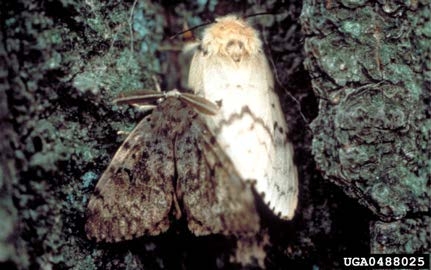
Females lay tan egg masses on tree trunks (Figs. 2 & 4), houses, lawn furniture, grills, fencing, dog houses, play equipment, firewood, yard ornaments, sheds, fencing, vehicles, trailers, and similar places. The egg masses usually measure 2.5-7.6 cm (1-3) inches long and look velvety due to hair from the female’s body. Spotted lanternfly lays a similar egg mass, but those are smooth and never furry. Spongy moth overwinters in the egg stage, and egg masses can be found from July until the caterpillars hatch the following March.
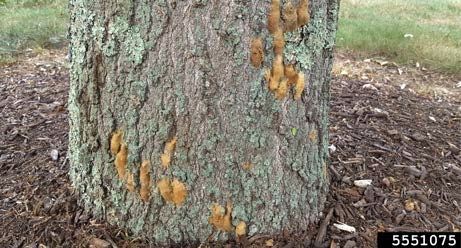
Hosts
Spongy moth caterpillars feed on the foliage of a wide range of trees. They prefer oak, maple, hickories, and birch, but will also attack fruit and nut trees, willow, dogwood, pine, and spruce. Oak trees on ridges are frequently infested.
Management
Chemical or biological insecticides are the most effective means of managing spongy moth populations, especially on large, forested properties. There are some insecticides that can be applied by the homeowner on smaller wooded properties. See the current Pest Management Guide for Home Grounds and Animals for a list of insecticides registered for use against spongy moth.
Large trees may require specialized equipment for complete spray coverage to manage spongy moth. However, there are simpler “hands on” approaches that are appropriate for homeowners with smaller properties or large specimen trees in their yards. These techniques are best for small lots with few trees and a relatively open canopy. Combining tactics, such as treating egg masses and banding trees, are the best management approach. These methods can be used along with insecticides available to homeowners. Thankfully spongy moth is rarely a problem across multiple years due to the sporadic nature of their populations.
Before Egg Masses Hatch
Spongy moth egg masses contain up to 1000 eggs. Destroying the egg masses before they hatch can reduce local populations. Starting in the fall, search your property for egg masses on tree trunks and other likely locations. In some areas of Virginia, spongy moths hatch as early as mid-March so egg masses should be destroyed before then. Use a putty knife, stiff brush, or a similar tool to scrape the egg masses into a plastic bag or container. Cover the egg masses with soapy water (dish detergent works well) and let soak for a day or two before discarding. Egg masses scraped off but left on the ground can still hatch in the spring.
Alternatively, saturate egg masses where found with a commercial solution of horticultural oil labeled for spongy moth control, or use a solution of soybean oil and water in a 1:1 ratio. The oil will smother the eggs and kill the developing caterpillars. Use a small spray bottle, a pump sprayer with a handheld wand, or a pumping squirt gun to soak the egg masses.
Tree Banding After Hatch
Older spongy moth larvae often travel down tree trunks during the day to seek shelter. When the caterpillars are seen on tree trunks, consider banding oaks or other high-risk landscape trees in the yard with burlap or sticky barriers. Banding can help protect individual trees but will not greatly reduce the general population in the immediate area.
Place burlap bands around tree trunks to intercept caterpillars on tree trunks. Wrap a strip of burlap 12- 18” (30-46 cm) wide around the tree at chest height and secure with a string about 6” below the top of the burlap band (Fig. 5). Let the top part of the burlap hang over the string to form a skirt around the trunk. Check under the hanging flap every day; late afternoon is an ideal time. Use a knife or similar tool to flick any caterpillars into a container of soapy water to drown (Fig. 6). Discard the caterpillars when dead. If you use a broom to sweep caterpillars off the trunk, be sure to step on them so they don’t climb back up.
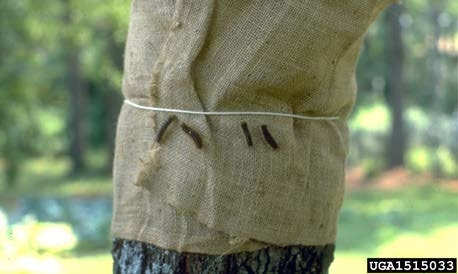
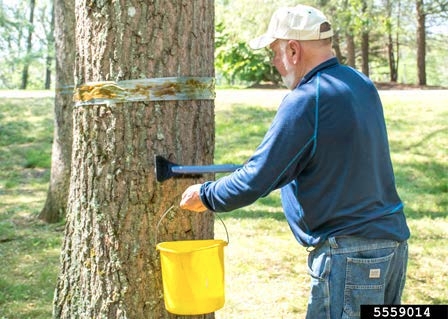
Spongy moth caterpillars may pupate under the burlap band flap. Knock any pupae into soapy water when found. This will reduce the number of adults laying egg masses in the fall. Avoid handling the caterpillars or pupae with bare skin as their hairs can cause a skin rash in sensitive individuals.
Sticky barrier bands can be made using duct tape or a nonporous material such as plastic stretch wrap film on a handle used for shipping. Wrap the tree to make a wide band completely around the trunk. Duct tape should be applied with the sticky side toward the trunk. Bands should be tight enough to avoid gaps where caterpillars can crawl under the band and continue up the trunk. On trees with rough or furrowed bark, you may need to use a layer of cotton batting under the band to keep the caterpillars from crawling through gaps under the material.
Smear a thin layer of commercially available insect barrier coating or petroleum jelly on the band to keep caterpillars from reaching the tree’s canopy (Fig. 7). Thick layers of petroleum jelly may melt off in the summer heat. Barrier coatings may need to be reapplied periodically, especially after a rain. Do not apply sticky substances directly on the tree trunk as they can stain or injure the tree. Duct tape applied sticky side out without a barrier coating will not remain sticky for long and allow caterpillars to cross it.
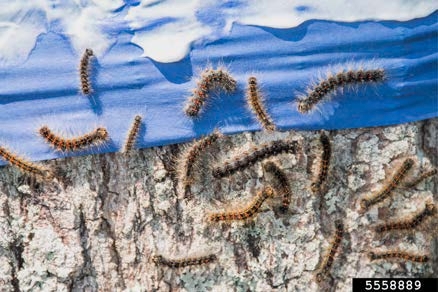
Routinely check barrier bands and knock any larvae or pupae found into soapy water (Fig. 6). Replace the bands when covered with debris that allows caterpillars to travel over the sticky surface. Both burlap bands and sticky barrier bands should be removed at the end of summer to avoid damage to the tree trunks.
There are many commercial barrier band kits available for spongy moth larvae. Some kits may also be labeled for use against cankerworm, spotted lanternfly, and other pests. Follow the label instructions for installing these kits.
Barrier bands sometimes trap beneficial insects, birds, and other animals in the sticky coating. Commercial slippery barrier tapes that caterpillars can’t cross can be used in place of sticky barrier tapes, but their performance may not be as satisfactory as using sticky bands.
Pheromone Trapping
Pheromone-baited traps are used by government agencies to monitor the presence of spongy moth populations. Pheromone traps only attract male spongy moths and many of them will have already mated before entering the trap. Pheromone trapping has no impact on the spongy moth population and is not an effective control tactic.
Quarantine
Most of Virginia is included in a quarantine for spongy moth. Spongy moth has expanded its range through human assisted movement of items with egg masses on it. Check outdoor equipment, trailers, and vehicles for egg masses before moving them to a new site. Buy and burn firewood on site instead of moving firewood that may have egg masses on it.
Mistaken Identities
Three other native caterpillars commonly found in Virginia are sometimes mistaken for spongy moth caterpillars. The eastern tent caterpillar (Malacosoma americana) hatches in the spring and is known for making silk nests in the crotches of apple and cherry trees. The hairy caterpillars have a light stripe down the back and small blue dots on the sides (Fig. 8).

The closely related forest tent caterpillar (Malacosoma disstria) prefers hardwood trees. Forest tent caterpillars often feed together but don’t make a silk tent like eastern tent caterpillars. The hairy caterpillars are dark with blue stripes and a single row of pale “keyhole” markings down the back (Fig. 8). Older larvae of both eastern tent and forest tent caterpillars are often seen wandering on tree trunks and the ground before they pupate.
Fall webworms (Hyphantria cunea) make messy silk nests around the foliage at the tips of deciduous tree branches in summer through fall. The caterpillars are variable in appearance, ranging from light yellow with dark spots or dark gray with reddish spots, but they are always covered with very long hairs (Figs. 9 & 10).
All three of these native species can defoliate trees, but rarely do they cause widespread defoliation like spongy moth. When large numbers of hairy caterpillars are seen on trees, it can be helpful to remember that only spongy moth caterpillars have four pairs of blue spots behind the head followed by six pairs of red spots down the back (Fig. 1).


Revision
Revised by T. Dellinger, 17 May 2024.
Virginia Cooperative Extension materials are available for public use, reprint, or citation without further permission, provided the use includes credit to the author and to Virginia Cooperative Extension, Virginia Tech, and Virginia State University.
Virginia Cooperative Extension is a partnership of Virginia Tech, Virginia State University, the U.S. Department of Agriculture (USDA), and local governments, and is an equal opportunity employer. For the full non-discrimination statement, please visit ext.vt.edu/accessibility.
Publication Date
June 4, 2024



